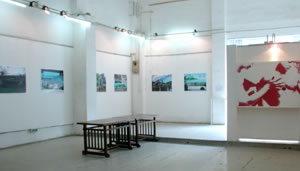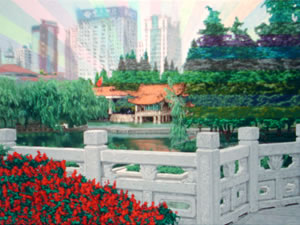Kunming Landscapes
In September 2004 I travelled to the city of Kunming, China, for an artist’s residency with fellow London-based artist and good friend Diego Ferrari. We were given studios at the Up River Loft Gallery alongside ten or so Chinese artists in the heart of the city. At the end of our two months stay we held an exhibition of our projects in China, as well as gave lectures about our work in three Chinese art colleges. I was invited to take part in the residency by the Triangle Arts Trust, financially supported by them and the Arts Council of England.
Before arriving I had some of the usual preconceptions about China. These consisted of images of the Great Wall, the Forbidden City, the Cultural Revolution, etc, and stereotypical classical and agricultural landscapes depicted in paintings and photographs. I had seen some articles and television programmes relating to China’s rapid economic expansion, the space-age skyline of Shanghai, for example. Chinese philosophy has interested me for many years, especially the Tao Te Ching by Lao Tzu and the I Ching, or Book of Changes, and its influence on western artists like John Cage. Before going, I researched into traditional Chinese painting, the varying styles and conceptions of the representation of landscape, favouring a vertical rather than horizontal approach to the depiction of space. When it came to Kunming, guidebooks and the Internet offered little in the way of visual information. On arriving I set out into the vast city with my digital camera to find scenes that could possibly be developed into paintings.
Kunming is a city of over five million people in the Southwest of China. It is the bustling capital of the province of Yunnan, bordering Tibet in the North, Burma in the West and Vietnam and Laos in the South. Many different ethnic groups populate this large region and the ancient city of Kunming reflects this diversity. The influx of rampant capitalism is most evident in mushrooming skyscrapers and giant advertising hoardings. Migrant workers come to support the huge economic expansion that is taking place. Much of old Kunming, with its traditional timber-framed buildings, has been swept away to make way for vast shopping centres and luxury apartments. Evidence of traditional ways of life and recreation is evident at street level in busy markets, cafés and restaurants. The brutal displacement of people with the reinvention of districts beyond recognition is not generally reflected in the spirit of the place, predominantly one of optimism and industriousness, with a strong sense of community, alongside extremes of wealth and poverty.
Kunming is known as the City of Eternal Spring due to the climate, which is relatively warm all year round. Only a few hundred miles north of the Tropic of Cancer, the heat is tempered by its elevation of two thousand meters. Chinese and foreign tourists flock to famous historic and natural attractions around the city, including the Stone Forest, Daguan Park, Dian-Chi Lake and the Western Hills, peppered with ancient Taoist and Buddhist shrines. Mists from the lake mixed with pollution often obscure the sun all day, lighting the city in a milky atmosphere.
After a few days of exploring and taking photographs it became clear that my project would be photographic in nature. This was not simply due to the daunting number of interesting scenes that I discovered, impossible to translate into paint in a limited stay. Many of the most exciting images involved layered representations of landscape, from digitally produced advertising imagery to wall painting. I also found numerous ‘landscapes in miniature’, ranging from historic rock gardens of spiritual significance to more recent assemblages of tree and stone facing imminent destruction from encroaching building sites. The passion for these hyper-gardens continues to the present where the road to the airport is lined with giant windmill-flowers, for example. The layering of these depictions of landscape amidst the architecture of the city elusively seemed to reflect traditional Chinese conceptions of landscape. Kunming had the appearance of a living painting, having associations with modernist approaches to landscape, from Cubism to Surrealism. The idea of spending my days shut in the studio painting seemed unnecessary or futile in front of astonishing combinations of landscape representation in two and three dimensions.
I largely avoided photographing the busy streets, often waiting ages or returning at quieter times when there was nobody in shot, or one solitary ‘figure in landscape’ was revealed. The identity of these lone figures is kept anonymous by the low resolution of the digital camera. With these images in particular an existential reading can be taken, echoing the displacement of people in this gigantic construction site. My intentions are not overtly political; they simply translate my own feelings of disconnection within an urban landscape, heightened by being in a foreign city. An air of mystery or expectation hopefully comes across more than one of dejection.
The naming of the images was something that developed through the editing process. Often the titles simply pick on an element in the picture, usually associated with landscape, natural forms or activities, not necessarily dominant within the image. Sometimes they have more subtle associations: In the photograph called Living Space the title is a translation of the Mandarin characters at the top; Grand View is the name in translation of the pavilion depicted.
Kunming Landscapes represent a very partial view of the city. Even in terms of landscape I have avoided using photographs of the magnificent parks and gardens the city is famous for. I have been drawn to places that challenge perceptions of space and time, where a sense of scale or history is confused.
My exploration of the city photographically could be taken (and was by some Chinese viewers) as a search for the exotic, yet I feel strongly that my quest was also for the familiar, both in terms of my urban existence in London, but more importantly, my particular researches into landscape painting. After all, Chinese images and music strongly influenced the modernist advances of artists and composers of the nineteenth and early twentieth century in Europe. I could not possibly claim to know Kunming after such a short stay. The use of it as a subject is as a container for my general responses to any metropolis or place where nature and culture collide. This hopefully does not contradict my strong appreciation and affection for the special qualities of the place, especially after visiting several other Chinese cities.
Photographs were taken on a 3.3 megapixel Nikon camera, already considered a low-resolution in 2004. They are uncropped from the original files and some simple colour and tonal adjustments have been made in Photoshop. Some large and small printing experiments have been undertaken, intending to reveal the digital nature of their production by accentuating pixel definition and colour saturation.
64 images have been selected for display here, echoing the number of chapters or states of flux represented in the I Ching.
Alongside taking photographs, I recorded sounds of the busy streets, often filled with music. This ranged from the continuously 'piped' generic music in the collossal trade market, competing CD emporiums, live street musicicians of various musical heritages, and morning exercise routines for factory workers.
Kunming soundscape, 2004, 18m09s.

View of Kunming Residents exhibition with Diego Ferrari at Up River Loft Gallery in 2004
I did produce one painting in Kunming:

Unicom
2004, oil on canvas, 45 x 60cm